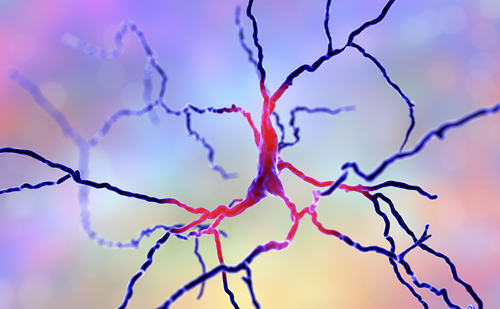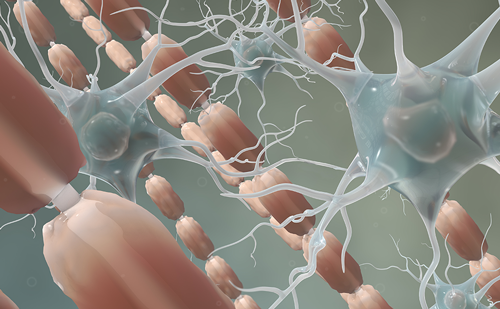Search Results
Showing Results for aquaporin-4

Welcome to the latest edition of touchREVIEWS in Neurology. We are excited to present a collection of articles that showcase the latest advancements and diverse perspectives in neurological research and treatment. This issue features insightful reviews and editorials from esteemed ...

Neuromyelitis optica spectrum disorders (NMOSD) are a group of relapsing autoimmune diseases of the central nervous system. The clinical hallmarks of NMOSD are myelitis and optic neuritis; however, a wider clinical spectrum has been recognized.1 The majority of patients with ...

Neuromyelitis optica spectrum disorder (NMOSD) is a rare inflammatory autoimmune disease of the central nervous system (CNS) with a worldwide distribution.1 The first clinical description of NMOSD was made a century ago by Devic and Gault, who documented patients with ...

Multiple sclerosis (MS) is a chronic, immune-mediated disorder of the central nervous system characterized by inflammation, demyelination and neurodegeneration. Natalizumab is a widely used anti-α4 integrin inhibitor for treating highly active MS. In the pivotal trials of natalizumab for MS, ...

CHAMPION-NMOSD (NCT04201262) is a study of ravulizumab in adults with anti-aquaporin-4 antibody-positive neuromyelitis optica spectrum disorder. Ravulizumab binds to the same complement component 5 epitope as eculizumab; however, its longer elimination half-life extends the dosing interval (every 8 versus 2 weeks). In this ...

Acute disseminated encephalomyelitis (ADEM), first characterized in 1931,1 is a non-specific clinical syndrome of polyfocal central nervous system (CNS) inflammatory demyelination; it is characterized by encephalopathy and large, poorly demarcated cerebral white matter lesions.2,3 Myelin oligodendrocyte glycoprotein (MOG) antibody-associated disease (MOGAD), ...

Over the past two decades, monoclonal antibodies targeting the surface antigen CD20 have emerged as highly effective disease-modifying therapies (DMTs) for multiple sclerosis (MS).1 The major mechanism of action of these therapies is via B-cell depletion, as CD20 is expressed ...

The CHAMPION-NMOSD trial (NCT04201262) is a global, open-label, multicentre, phase 3, externally controlled study of ravulizumab in adults with anti-aquaporin-4 antibody-positive neuromyelitis optica spectrum disorder (NMOSD). In this touchNEUROLOGY interview, we caught up with Prof. Sean Pittock (Mayo Clinic, Rochester, MN, ...

The CHAMPION-NMOSD trial (NCT04201262) is a global, open-label, multicentre, phase 3, externally controlled study of ravulizumab in adults with anti-aquaporin-4 antibody-positive neuromyelitis optica spectrum disorder (NMOSD). In this touchNEUROLOGY interview, we caught up with Prof. Sean Pittock (Mayo Clinic, Rochester, MN, ...

Infection of the central nervous system (CNS) due to cytomegalovirus (CMV) is rare, as it typically occurrs in immunocompromised patients and rarely affects those who are immunocompetent.1 Brain infection – manifested by meningoencephalitis – is much more common than infection of the ...

Aquaporin 4-immunoglobulin G (AQP4-IgG) plays a major role in the pathogenesis of neuromyelitis optica spectrum disorder (NMOSD). Prof. Jeffrey Bennett (University of Colorado School of Medicine, Aurora, CO, USA) discusses the challenges in the treatment of NMOSD. Questions: What ...

Satralizumab is a humanized monoclonal antibody medication that is used for the treatment of neuromyelitis optica spectrum disorder (NMOSD), a rare autoimmune disease, with Aquaporin 4-immunoglobulin G (AQP4-IgG+) playing a major role in its pathogenesis. Prof. Jeffrey Bennett (University ...

Neuromyelitis optica spectrum disorder (NMOSD) is an inflammatory disease of the central nervous system (CNS) and is known to cause recurrent episodes of optic neuritis and transverse myelitis. Myelitis is radiologically referred to as longitudinal extensive transverse myelitis on spinal ...

Neuromyelitis optica spectrum disorder (NMOSD) refers to a family of inflammatory central nervous system (CNS) diseases in which patients accrue disability through severe episodes of demyelination with typical manifestations including involvement of visual pathways (e.g., optic neuritis) and spinal ...

Sean Pittock (Mayo Clinic College of Medicine, Rochester, MN, USA) shared with us his expert insights from the phase 3 PREVENT study, a randomized controlled trial of eculizumab in AQP4 antibody-positive participants with neuromyelitis optica (ClinicalTrials.gov Identifier: NCT01892345), including a ...

Great to have an opportunity to speak with Celia Oreja-Guevara (University Hospital San Carlos and University Complutense, Madrid, Spain) around the highlights of her presentation entitled: Regional outcomes of eculizumab treatment in patients with aquaporin-4 immunoglobin G-positive neuromyelitis optica spectrum ...

Myelopathy is a common diagnosis often made by clinical neurologists and can be a cause of significant disability. Differential diagnosis classically includes structural etiology, demyelinating, metabolic, nutritional, inherited, and degenerative causes, resulting in a vast array of pathophysiologic processes, underlying ...

Understanding MS Better in 2014Contribution of Epidemiological factorsMultiple sclerosis (MS) is considered to be an immune-mediated neuro-inflammatory and neurodegenerative disease of the central nervous system (CNS) with heterogeneous clinical presentation and course, neuroimaging and pathological findings. Several genetic and environmental ...
Latest articles videos and clinical updates - straight to your inbox
Log into your Touch Account
Earn and track your CME credits on the go, save articles for later, and follow the latest congress coverage.
Register now for FREE Access
Register for free to hear about the latest expert-led education, peer-reviewed articles, conference highlights, and innovative CME activities.
Sign up with an Email
Or use a Social Account.
This Functionality is for
Members Only
Explore the latest in medical education and stay current in your field. Create a free account to track your learning.

